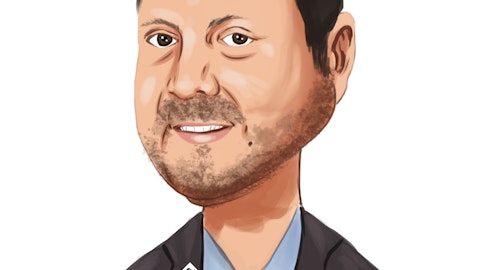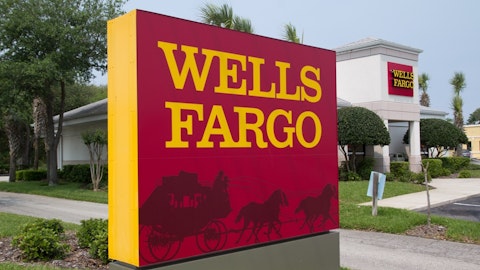Siti Panigrahi: Sam, it’s good to see focus on profitability side. Just wanted to ask on the revenue side. Your service revenue, I say organic services revenue growth was flat, excluding Fuze. So you did talk about CCaaS, but what do you see in terms of macro trend, anything on the enterprise side? Is it definitely disoriented. What are you seeing in the market right now?
Samuel Wilson: I — it’s a fair question, and yes, your math is correct. It’s just — it’s a little hard for me to tell. We took an action in the beginning of October, and we took another action in January. So both of those had consequences. And as we said earlier, we’re walking away from low margin or negative margin revenue for improved profitability. We think the improved profitability allows us to delever our balance sheet, just makes the company better off and allows us to reallocate investments in the better ROIC areas. So I think absolutely, economics played a relatively small role in the revenue performance, it was really self-generated. And the other thing I would say is I think that reallocation of investment is working, deferred revenue’s up quarter-on-quarter, deferred commission’s up quarter-on-quarter, RPO’s up quarter-on-quarter and retention at the highest levels we’ve seen in a long time.
So in terms of the underlying indicators of a healthy SaaS business, they all got better last quarter. And so I sort of believe that the right play right now is to sacrifice a little bit of revenue growth to make all those things substantially better.
Siti Panigrahi: And then in the CPaaS business, I know you talked about weakness in the CPaaS business the last few quarters. So wondering what’s the current run rate of CPaaS right now?
Samuel Wilson: We don’t disclose that. As Kevin mentioned in his script, it’s 1 of the things that we’re looking at disclosing potentially in future quarters, so we kind of put the breadcrumbs out there, but it’s under review.
Operator: The next question is from the line of Catharine Trebnick with Roth Capital Partners. Your line is now open.
Catharine Trebnick: Sam, when you talked about your bullet point #5, Asia Pac and CPaaS revenue has been down. What other assets are you looking to build that up with, so you can really drive that as a key growth driver?
Samuel Wilson: It’s a completely fair question. So I think in the past, we missed a bit of a product cycle in CPaaS in Asia. And you could — like I can get into more details in — at another time, but just we missed the product cycle, and we sort of caught up on that. We’re investing in the platform in the business. Our unit volumes have continued to increase. And we’re continuing to land brand name customers, as I mentioned in the prepared remarks. And so I think the business funnel is there, et cetera. We just need to close the gap on a few product features. And there’s some other news that’s coming in the near future on that front also in the CPaaS business. And so I think that the stars are starting to align for us to turn that business around. It is taking longer than we had expected, and I grant that to everyone, but I think the stars are therefore, to turn around and do better.
Catharine Trebnick: Well, then, you also then layer on your CCaaS business in like the Australian market, it seems like that would be a right market for you.
Samuel Wilson: I know I don’t want to pooh, pooh, the Australian market. It just happens to be that Australia is like the 58th largest population country in the world and the State of California is the sixth. I’m not sure if I wouldn’t rather invest in California than in Australia. Right now, we’re investing pretty aggressively in the U.S., U.K., California — I’m sorry, Canada, Ireland, because those are just great contact center markets right now for us.
Operator: The next question is from the line of George Sutton with Craig-Hallum. Your line is now open.
George Sutton: Sam, you talked about the importance of your customer recommendations to their peers, as being a driver of your business. Can you talk about that in a little more detail? Is that something you’ve actually seen? And is that — is there something you can quantify there?
Samuel Wilson: Kate may know the quantification numbers off the top of her head, but 1 of the things that we’ve been very focused on over the last few quarters has been improving our reference ability. So we really were talking about NPS, so there’s notion of referenceability and we saw a pretty substantial increase in our referenceability. This all goes sort of full circle, right? So in my prepared remarks, I talked about our investment in customer success. Kevin talked about the very high retention rates we’re having. That in turn leads to happy customers, happy customers give good references, which then, in turn, drives RPO improvements and deferred revenue improvements and those kinds of things, right? So we’re trying to get that virtuous cycle, maybe spinning a little faster than it has in the past.
George Sutton: Just as a follow-up. You mentioned customer churn is something you’re comfortable with. I’m curious if you can talk about seat churn. And of course, as we’re starting to see some layoffs around the market. Is that starting to have an impact in the results?
Samuel Wilson: I’ll let Kevin follow up if you want to add anything. Look, so when we talk about retention, we talk about logo plus seats, right? So if a customer down sells from 100 seats to 90 seats, where a customer goes from 10 seats to 0, we count that the same. And last quarter, we had the highest retention in many years. And so I don’t think it’s that much — I think what’s interesting is we’re launching a lot of really important things, Conversational IQ, some of the things we have in beta, et cetera. So even if we’re seeing a little bit of ARPU decrease from the core product, just the number of seats, we are seeing an uptick in the number of add-ons going into our contact center.
Kevin Kraus: Yes. I think — so on the customer retention, we need to go back over more than 3 years to get — I just can’t find any numbers for more than 3 years that are better than the ones that we just put up this quarter. I will also say that we’re making the right investments in global customer care and delighting our customers. So it’s really starting to pay dividends for us, and we’re keeping the right high-value customers. And looking forward, although we don’t give guidance on this, we do look out. We’re very, very proactive about what customers are renewing, what’s coming up, and we address any risks that way. We’re doing a really good job of that right now. So I think that’s reflected in our recent trend.
Operator: The next question is from the line of Will Power with Baird. Your line is now open.
Will Power: Yes, I guess I had a question on the revenue guidance, both for fiscal Q4 and in ’24, thanks for the initial framework there. And I guess I recognize that CPaaS is going to be a headwind. You’ve talked about that. Is there any way to kind of help us parse apart what you’re seeing in kind of XCaaS and CCaaS, which I know is the strategic priority versus UCaaS? I mean are there demonstrably different growth rates there? Any color you could provide on that front?
Samuel Wilson: Yes. I mean, I’ll start, and I’ll let Kevin fill in. So a couple of things, right? So XCaaS is now almost 40% of our ARR and has growth rates well in excess of what we’re seeing across the whole business, right? So the whole business is flat and our growth rate in XCaaS is high 20s. And so definitely a situation where we’ve got a lot of moving pieces under the table. CPaaS, you mentioned small business, UCaaS. It had an okay quarter this quarter. It was kind of flattish on a year-over-year basis, right, up 4%, those kinds of things. But not blowout numbers. And so we are still under the covers. I think all of this is starting to show up in a complete soup though, right? XCaaS, our contact center doing better. That’s driving higher growth rates in enterprise. And small business is starting to become a smaller and smaller component of the overall ARR mix. And so as all that flushes out over time, we should naturally see a lift in growth rates.
Will Power: Let me ask you 2 then maybe this ties into that. I mean you noted RPO was — had a nice sequential increase. And what’s helping drive that? I mean is that XCaaS adoption? What are kind of the key pieces of that?
Samuel Wilson: Yes. no, I mean, I’d love to make it — well, I’d love to make it super sophisticated and cool, but — we had a good quarter for XCaaS sales, right? The combination of UC, CC and a world-class Microsoft Teams integration, I mean we mentioned right? Microsoft Teams triple-digit growth year-over-year. That’s pulling in our contact center. Our contact center then has higher dollar ARPUs attached to it and good margins associated with it. So if we can just keep in princing and repeating that, the numbers will continue to get better.
Kevin Kraus: Yes. We also — I mean, in addition to the strong new logo bookings, we had a great renewal quarter as well, which is indicative of the investments we’re making in delighting the customers.
Samuel Wilson: Thank you for calling that out, Kevin.
Kevin Kraus: So that’s reflected in our RPO. Our deferred revenue is also up quarter-over-quarter as well.
Samuel Wilson: Yes. And XCaaS has a net dollar retention well in excess of 100, right? So like the more that XCaaS becomes a bigger part of the business, the more the math starts to work itself out.
Will Power: And I’m sorry, maybe just a quick clarification. On the — for fiscal ’24 on the operating margin guidance, I think you said 400 to 500 basis points. Was that above the full year fiscal ’23? Or is that above the exit rate of ’23?
Kevin Kraus: Yes, we took about 7.5% we’ll have for the full year and then just add 400 to 500 basis points on top of that for the full year, but we do expect a steady improvement on the strength of the balance sheet.
Operator: The next question is from the line of Peter Levine with Evercore ISI. Your line is now open.




